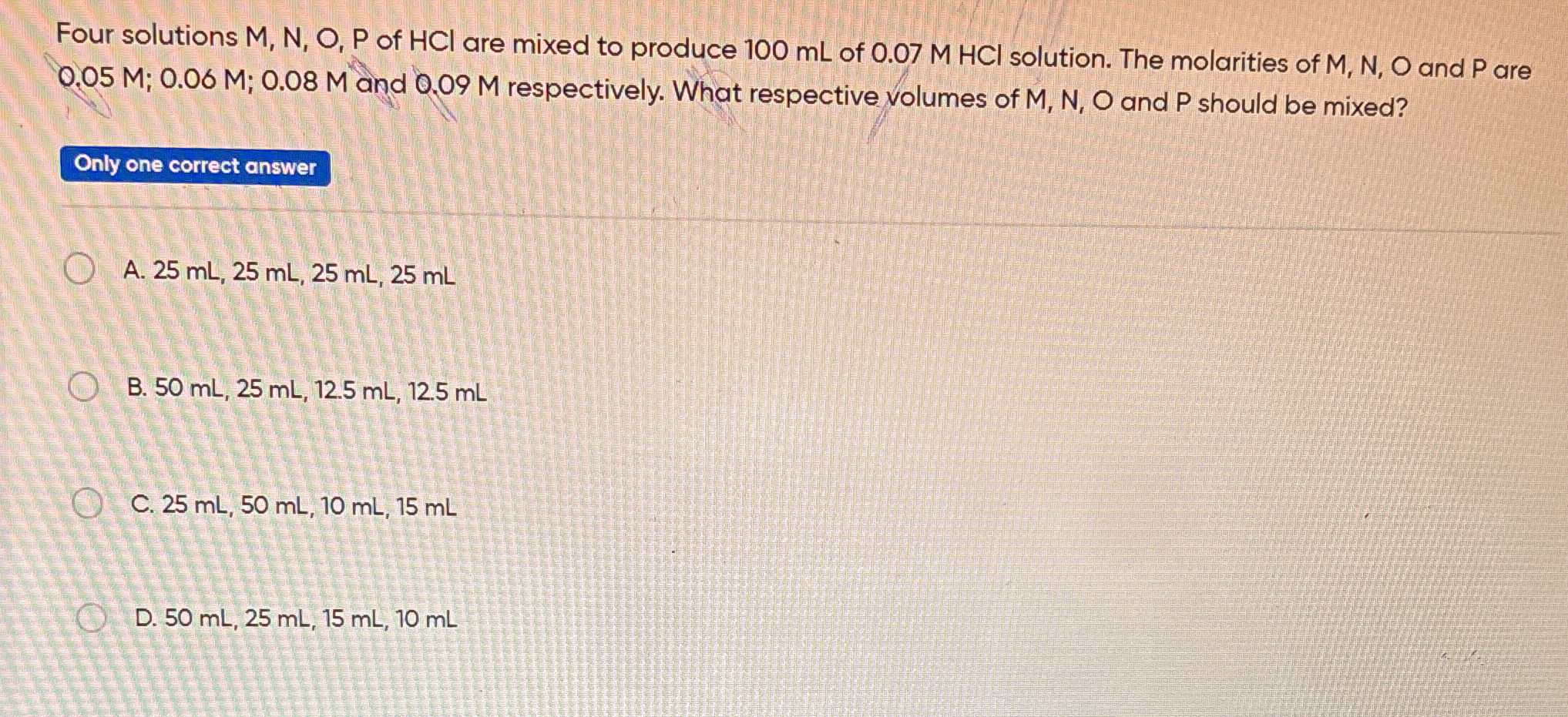Four solutions M, N, O, P of HCl are mixed to produce 100 mL of 0.07 M HCl solution. The molarities of M, N, O and P are 0.05 M, 0.06 M, 0.08 M and 0.09 M respectively. What respec... Four solutions M, N, O, P of HCl are mixed to produce 100 mL of 0.07 M HCl solution. The molarities of M, N, O and P are 0.05 M, 0.06 M, 0.08 M and 0.09 M respectively. What respective volumes of M, N, O and P should be mixed?

Understand the Problem
The question is asking how to mix four solutions of hydrochloric acid (HCl) with different molarities to obtain a final solution of specific concentration. The goal is to determine the volumes of each of the four solutions needed to prepare 100 mL of a 0.07 M HCl solution.
Answer
The respective volumes of M, N, O, and P should be \( 50 \, \text{mL, } 25 \, \text{mL, } 15 \, \text{mL, } 10 \, \text{mL} \).
Answer for screen readers
The correct volumes of M, N, O, and P are ( 50 , \text{mL,} , 25 , \text{mL,} , 15 , \text{mL,} , 10 , \text{mL} ), respectively (Option D).
Steps to Solve
- Define the problem variables
Let the volumes of solutions M, N, O, and P be represented as ( V_M, V_N, V_O, ) and ( V_P ) in mL.
- Set up the total volume equation
The total volume of the mixed solution must equal 100 mL:
$$ V_M + V_N + V_O + V_P = 100 $$
- Set up the concentration equation
The total moles of HCl in the mixed solution should equal the moles in the final desired solution. The desired concentration is 0.07 M in 100 mL, which gives:
$$ \text{Total moles of HCl} = 0.07 \times 0.1 = 0.007 , \text{moles} $$
- Calculate the moles contributed by each solution
Using their molarity, the moles from each solution can be expressed as:
$$ 0.05 \times \frac{V_M}{1000} + 0.06 \times \frac{V_N}{1000} + 0.08 \times \frac{V_O}{1000} + 0.09 \times \frac{V_P}{1000} = 0.007 $$
- Simplify the moles equation
Multiply through by 1000 to eliminate the fractions:
$$ 0.05 V_M + 0.06 V_N + 0.08 V_O + 0.09 V_P = 7 $$
- List the equations to solve
You will have the following equations to solve:
-
( V_M + V_N + V_O + V_P = 100 )
-
( 0.05 V_M + 0.06 V_N + 0.08 V_O + 0.09 V_P = 7 )
-
Trial and error with options
Now we can substitute the volumes given in the options A, B, C, and D into the equations to find which set of volumes satisfies both equations.
The correct volumes of M, N, O, and P are ( 50 , \text{mL,} , 25 , \text{mL,} , 15 , \text{mL,} , 10 , \text{mL} ), respectively (Option D).
More Information
This problem involves using equations based on the conservation of mass (in this case, volume and concentration) to create a solution with a desired concentration from multiple mixtures. Understanding how to combine solutions of different concentrations is crucial in chemistry.
Tips
- Not converting from mL to L when calculating moles. Remember to divide the volume in mL by 1000 to convert to L.
- Forgetting to ensure that the total volume sums to 100 mL while also satisfying the concentration condition.
AI-generated content may contain errors. Please verify critical information